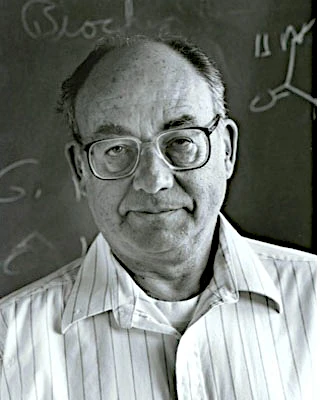
Stanley Lloyd Miller (1930 – 2007) was an American chemist famous for his pioneering experiment on the origin of life. Born on March 7, 1930 in Oakland, California, into a middle-class family, he developed an early interest in chemistry. After studying at the University of California, Berkeley, he earned his doctorate in 1954 under the supervision of Harold Urey (1893-1981), a Nobel Prize-winning chemist known for his work on the deuterium isotope.
It was under Urey's influence, who in 1952 proposed a theory about the composition of Earth's primitive atmosphere (a reducing mixture of methane, ammonia, hydrogen and water vapor), that Miller designed his historic experiment.
In 1953, while still a doctoral student, Miller conducted an experiment that would mark the history of science. In a sterilized glass apparatus, he recreated the presumed conditions of the primitive Earth:
After just one week, Miller observed the formation of amino acids (including glycine, alanine and aspartic acid), the basic building blocks of proteins. This experiment, published in Science in 1953, demonstrated for the first time that complex organic molecules could form spontaneously from simple inorganic compounds under conditions similar to those of the primitive Earth.
Miller's experiment had an immediate and profound impact on several fields:
| Field | Contribution | Consequences |
|---|---|---|
| Exobiology | First experimental demonstration of abiotic synthesis of organic molecules | Foundation of the field of the origin of life |
| Prebiotic Chemistry | Validation of the hypothesis of a reducing primitive atmosphere | Stimulus for numerous researches on primitive Earth conditions |
| Molecular Evolution | Showed that amino acids could form naturally | Support for the theory of chemical evolution before biological evolution |
| Popular Culture | Experiment became iconic of 20th century science | Inspiration for many books and documentaries on the origin of life |
However, the experiment also faced criticism:
After his doctorate, Miller pursued a distinguished academic career:
His subsequent research focused on:
Although the details of the primitive atmosphere remain debated, Miller's experiment remains a fundamental milestone:
As Carl Sagan (1934-1996) noted: "The Miller-Urey experiment was a decisive moment. For the first time, it was shown that complex organic molecules essential to life could form under conditions that probably existed on the primitive Earth."
After Miller's death in 2007, more advanced analyses of his original samples revealed even more significant results:
| Year | Discovery | Significance |
|---|---|---|
| 2008 | Identification of 22 different amino acids (compared to 5 initially reported) | Demonstrates much greater chemical complexity than previously thought |
| 2011 | Discovery of non-proteinogenic amino acids | Suggests alternative chemical pathways in prebiotic evolution |
| 2014 | Detection of complex volatile organic compounds | Indicates the formation of molecules more complex than amino acids |
| Year | Event | Context |
|---|---|---|
| 1930 | Born in Oakland, California | In a middle-class family |
| 1951 | Earned his bachelor's degree in chemistry at UC Berkeley | Beginning of his interest in the origin of life |
| 1952 | Met Harold Urey in Chicago | Beginning of his thesis on the primitive atmosphere |
| 1953 | Conducted the historic experiment | Published in Science the same year |
| 1954 | Earned his doctorate | Thesis supervised by Harold Urey |
| 1960 | Became professor at UCSD | Beginning of a 39-year career |
| 1983 | Received the Oparin Prize | For his contributions to the study of the origin of life |
| 2007 | Died in National City, California | From complications of a stroke |
| 2008 | Reanalysis of his original samples | Discovery of additional molecules |
Miller's experiment had a significant impact beyond the scientific world: